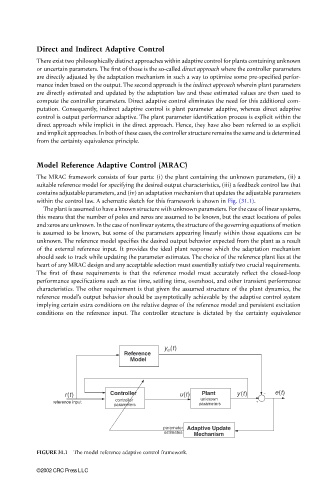Page 942 - The Mechatronics Handbook
P. 942
0066_frame_C31.fm Page 5 Wednesday, January 9, 2002 7:49 PM
Direct and Indirect Adaptive Control
There exist two philosophically distinct approaches within adaptive control for plants containing unknown
or uncertain parameters. The first of those is the so-called direct approach where the controller parameters
are directly adjusted by the adaptation mechanism in such a way to optimize some pre-specified perfor-
mance index based on the output. The second approach is the indirect approach wherein plant parameters
are directly estimated and updated by the adaptation law and these estimated values are then used to
compute the controller parameters. Direct adaptive control eliminates the need for this additional com-
putation. Consequently, indirect adaptive control is plant parameter adaptive, whereas direct adaptive
control is output performance adaptive. The plant parameter identification process is explicit within the
direct approach while implicit in the direct approach. Hence, they have also been referred to as explicit
and implicit approaches. In both of these cases, the controller structure remains the same and is determined
from the certainty equivalence principle.
Model Reference Adaptive Control (MRAC)
The MRAC framework consists of four parts: (i) the plant containing the unknown parameters, (ii) a
suitable reference model for specifying the desired output characteristics, (iii) a feedback control law that
contains adjustable parameters, and (iv) an adaptation mechanism that updates the adjustable parameters
within the control law. A schematic sketch for this framework is shown in Fig. (31.1).
The plant is assumed to have a known structure with unknown parameters. For the case of linear systems,
this means that the number of poles and zeros are assumed to be known, but the exact locations of poles
and zeros are unknown. In the case of nonlinear systems, the structure of the governing equations of motion
is assumed to be known, but some of the parameters appearing linearly within those equations can be
unknown. The reference model specifies the desired output behavior expected from the plant as a result
of the external reference input. It provides the ideal plant response which the adaptation mechanism
should seek to track while updating the parameter estimates. The choice of the reference plant lies at the
heart of any MRAC design and any acceptable selection must essentially satisfy two crucial requirements.
The first of these requirements is that the reference model must accurately reflect the closed-loop
performance specifications such as rise time, settling time, overshoot, and other transient performance
characteristics. The other requirement is that given the assumed structure of the plant dynamics, the
reference model’s output behavior should be asymptotically achievable by the adaptive control system
implying certain extra conditions on the relative degree of the reference model and persistent excitation
conditions on the reference input. The controller structure is dictated by the certainty equivalence
y (t)
m
Reference
Model
r(t) Controller u(t) Plant y(t) − e(t)
controller unknown
reference input +
parameters parameters
parameter Adaptive Update
estimates Mechanism
FIGURE 31.1 The model reference adaptive control framework.
©2002 CRC Press LLC

